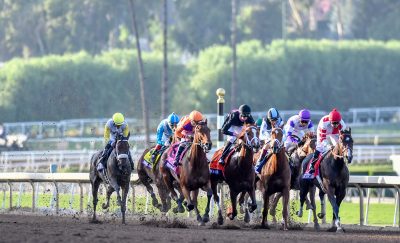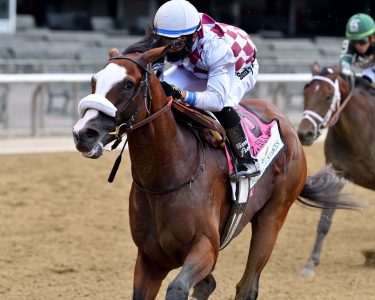By Ray Wallin
We all know people that are good handicappers but horrible bettors. My wife will tell you that I sometimes fall into that category. I have made a lot of progress in both my wagering and handicapping that has led me to year after year of profits at the track as a part-time player.
Even after all the great lessons that my late Uncle Dutch taught me on the apron of the Monmouth Park grandstand during a teenage summer, I still found myself making bad decisions through my college years. Having found a way to “right the ship” I can see traits that many good handicappers have that they need to change to become great handicappers. For me it was a long grind to figure some of these out and I try to impart some of this knowledge to other new handicappers to help them speed along the learning curve.

Horse Racing – US Racing Photo
Recently I read the book Decisive by Chip and Dan Heath. This book is a fascinating dive into our decision making process and some of the biases we face. They boil down the decision making process to four steps – encountering a choice, analyzing options, making a choice, and living with it. Yet, at each stage there is a “villain” that affects each step that we can’t remove, but we can use discipline to counteract them.
“Sometimes the hardest part of making a good decision is knowing there’s one to be made.” – Chip & Dan Heath
Having realized that I have fallen victim to the villains that the Heath’s describe at each step of the process, I was able to spot them in a fellow horseplayer back in my days spent on the second floor of the old Meadowlands grandstand.
The Schnoz was a regular on Wednesday nights who got his name from the monstrous honker he had front and center on his face. He also happened to be a good handicapper. He did a lot of the right things; he kept records, he watched replays and made trip notes, he kept stats that others didn’t think to keep, he did both premortems and postmortems on the races, and he hoarded a ton of data. What he didn’t do well was make decisions.
More often than not the Schnoz would lose. He focused in on one way the race could set up and that was it, considering no other options. He often would rush a new idea to the betting windows without spending much time analyzing how it may perform. He would sometimes make rash decisions, often letting his emotions get the best of him. Lastly, when he lost it was ugly. The past performances he had printed the day before and done hours of analysis on would go flying and garbage cans would feel his wrath.
When I read this book I got déjà vu. I immediately thought of the Schnoz. We had often had conversations between each race and I offered him my advice on where he had room for improvement. While I used different words to explain this to him, I liked how the Heath’s used the mnemonic of WRAP.
Widen Your Options
One of the fundamental flaws of the Schnoz’s handicapping was that he only locked into one way he saw the race setting up. Almost every race I handicap has multiple possible pace scenarios. While my most probable pace scenario is correct most of the time, you have to consider that not every race will go the way you expect. What if your critical pace horse is a frontrunner and doesn’t break well or gets knocked around at the break and can’t make the lead? What if some horse that hasn’t beaten any horses in their listed past performances bolts for the lead and duels with the one dimensional front runner you feel has a huge pace advantage? You’re done before you started.
You need to look at a couple of what-ifs and develop contenders based on other possibilities. Depending on how you see the multiple scenarios setting up, you can craft your wagers to include them.
Reality Test Your Assumptions
Playing on paper and back-fitting data are great ways to find an idea that may work. Sometimes there will be multiple horses within a race that meet a certain criteria and after the fact you think you have figured out the tie-breaker. All this gives you a good theory and basis for seeing if your angle or figure is viable.
Nothing replaces playing it real-time. I am not suggesting that you plunk down your hard-earned cash on an untested angle like our friend the Schnoz did. I am suggesting that you play it on paper real-time. We can all be influenced to lobby for one horse over another when there are multiple qualifying horses, but doing it in real-time before the race is run is a better test.
Attain Distance Before Deciding

Tiz the Law, winner at Belmont Stakes 2020 – Photo Courtesy of Joe Labozzetta/NYRA
The Schnoz was notorious for making bad decisions with late scratches and changes in a race. One night I remember hearing the track announcer call out that there was a late jockey change in the next race. Lackluster Larry the Winless Jockey was being replaced by Jersey Joe Bravo. When the Schnoz heard this his head peaked up from his past performances like a hunting dog that sensed some game. Without hesitation he was off to the windows to put a few bucks on Jersey Joe’s horse.
You can guess how this worked out for him. The old garbage can had a few more dents after that race. The problem was that the Schnoz would react immediately to information. He wouldn’t take any time to process it.
When you are faced with new information that requires you to change your handicapping, it is best to make that change and to then reassess what that means to the rest of the race. Did having a jockey change alter what the pace was going to be like in that race? Not really. However if there had been a late scratch you would need to look at how the pace sets up again, regardless if the scratched horse was a contender or not.
Take the time you need to reconsider a race before bolting to the windows like the Schnoz.
Prepare To Be Wrong
No one is going to win every race and wager. If they did, someone would get wise and every win bet would return $2.10. You have to accept that not every sure-thing bet you place is going to win. Not every horse that meets your best angle is going to dominate and win as you expect. You have to not let a loss cause you to become too emotional and throw a tantrum like our friend the Schnoz did when he went all Mike Tyson on that garbage can.
Accept that not every wager will be a winning one. There is a lot of chaos that can happen in any race that will leave you scratching your head. Lose, learn from it, and move on.
By acknowledging and working on a handful of traits, you can improve your handicapping and wagering. Remember to consider that there can be multiple options on how a race will be run and that you aren’t going to be right every time. By taking the time you need and building confidence in your handicapping and wagering maybe you will one day make your living playing the races.

Ray Wallin is a licensed civil engineer and part-time handicapper who has had a presence on the Web since 2000 for various sports and horse racing websites and through his personal blog. Introduced to the sport over the course of a misspent teenage summer at Monmouth Park by his Uncle Dutch, a professional gambler, he quickly fell in love with racing and has been handicapping for over 25 years.
Ray’s background in engineering, along with his meticulous nature and fascination with numbers, parlay into his ability to analyze data; keep records; notice emerging trends; and find new handicapping angles and figures. While specializing in thoroughbred racing, Ray also handicaps harness racing, Quarter Horse racing, baseball, football, hockey, and has been rumored to have calculated the speed and pace ratings on two squirrels running through his backyard.
Ray likes focusing on pace and angle plays while finding the middle ground between the art and science of handicapping. When he is not crunching numbers, Ray enjoys spending time with his family, cheering on his alma mater (Rutgers University), fishing, and playing golf.
Ray’s blog, which focuses on his quest to make it to the NHC Finals while trying to improve his handicapping abilities can be found at www.jerseycapper.blogspot.com Ray can also be found on Twitter (@rayw76) and can be reached via email at ray.wallin@live.com.


